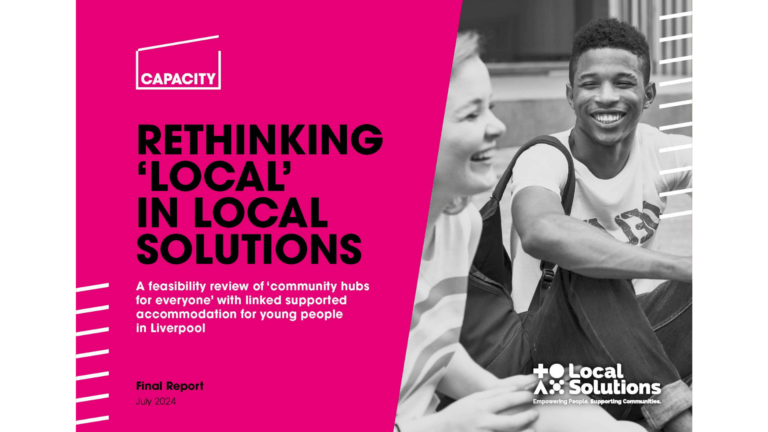Putting the ‘Local’ in Local Solutions: Creating a roadmap for change
- September 6, 2024
- Categories: Capacity Insights
Here at Capacity, we’re big fans of using a Theory of Change (ToC) process to sharpen our focus and clarify our goals. A ToC is a powerful tool that can help your organisation turn its aspirations into actionable plans that will have a real social impact. Not only is a ToC useful for evaluation or funder bids, but it can also be used to shape and support strategic thinking. We’re excited to share how we recently worked with Local Solutions to create a ToC for a new model of service delivery. To support even more organisations, we’ve developed a step-by-step guide that will make it easier to map out your strategy with confidence.
Our Social Climbers programme has given us the opportunity to connect with, and support, some brilliant local organisations with social purpose at their heart. One of these organisations is Local Solutions, a charity supporting individuals, families and communities experiencing disadvantage, exclusion and vulnerability across the Liverpool City Region and Wales.
Earlier this year, Local Solutions approached Capacity for our support to explore the feasibility of an idea – to develop high street community hubs where people could access their services, with quality accommodation for young people attached. This idea aimed to tackle a number of interconnected issues including the need for community partnership spaces, place-based coordination and suitable accommodation for young people using their homelessness services.

To supplement a feasibility report, we worked with the Local Solutions to develop a Theory of Change to support the team to articulate the impact they want this work to have and how they intend to achieve it. Over a number of months, the Capacity team met with Local Solutions’ Senior Leadership Team to host a series of interactive sessions, working through a ToC exercise.
We want to share how utilising a ToC approach brought a new level of clarity to Local Solutions’ idea, providing the team with a structured way to think strategically about their ambitions. We’ve also developed a ToC resource to support your organisation work through a similar process.
Before getting stuck into drafting a ToC, it’s really important to get clear on what you’re trying to achieve and why you’re trying to achieve it. Starting with identifying the overall aim of your project (the impact you want to have) and the problem you’re trying to solve, provides clear focus and direction for your work.
We used our first session with the team to get to grips with the problems they are trying to solve, the context they are operating in and thinking about what success will look like for Local Solutions. We supported the team to identify and articulate their vision – the long-term impact they want this work to have for their stakeholders, which helped us to understand the change they are trying to make.
By working backwards, the ToC process can support your organisation to make sure that its strategies are tightly aligned with its goals and that every action taken is directed towards achieving meaningful impact.
Starting with the long-term impact, we supported the Local Solutions team to trace back the necessary steps to achieving their aims. We identified a number of outcomes for their stakeholders at different stages of the project, then thought about what activities would lead to these outcomes and the resources needed to deliver them. This brought a new level of clarity to their plans, fleshing out the initial idea by identifying a series of key interventions required to bring about change.
A ToC encourages you to name the barriers and enablers to achieving change. Identifying the factors and conditions that can prevent or support the change process means that you’ll be able to allocate resources more effectively, manage risks and adapt to changing circumstances.
Once we’d identified the context, vision, outcomes, activities and resources, we supported the Local Solutions team to think about what conditions needed to be in place to achieve their impact and what barriers could prevent this change from coming about. We were able to identify a range of enablers and barriers (both internal and external) from strong leadership to availability of suitable space. This made explicit the conditions required to make their vision a reality.
Working through a ToC can provide your organisation with an ideal opportunity to check and challenge pre-existing beliefs about how change will occur, enabling scrutiny and testing the validity of your assumptions. This increases the likelihood that you’ll achieve meaningful and sustainable outcomes.
As a critical friend, the ToC process provided us with a chance to test Local Solutions’ assumptions and check logical connections between the planned activities and outcomes to make sure they clearly contributed to their overall vision. We were able to identify any gaps in Local Solutions’ thinking, stretching the team to consider different pathways towards their ultimate goal.
Undertaking a ToC process will help you to assess how realistic and achievable your plans are given the resources, time and context you’re operating in. This will help you ensure that your goals are attainable and the necessary conditions for change are within reach.
The ultimate purpose of our work with Local Solutions was to explore the feasibility of a new model of delivery – community hubs with attached accommodation for homelessness services. Developing a ToC alongside the team in the early stages of the project – before getting stuck into the feasibility study – allowed us to undertake some initial strategic thinking about how realistic Local Solutions’ idea was and explore some alternative routes to achieving their goals.

All this work led to the production of a detailed feasibility review of ‘community hubs for everyone’ with linked accommodation for young people, which identified two potential options for Local Solutions to take forward. We produced an appraisal of these options, with SWOT analysis and detailed financial modelling for each.
Based on our final report, Local Solutions are now in the process of reviewing the work and making plans based on our recommendations. We’re excited to continue working with Local Solutions in the future and are looking forward to seeing their plans come to fruition.

Developed by Capacity, with funding from Postcode Innovation Trust and UKSPF, Social Climbers is a business support programme delivered with Kindred and other local partners. We’re on a mission to create headspace for leaders and doers to sit down, slow down and think about growth.
We’ve heard strong feedback – not just from Local Solutions but from others we’re supporting – about how our Social Climbers is providing busy leaders with the space, time and expertise to think. We’ll be continuing to work with some brilliant third sector organisations and social enterprises throughout the duration of 2024, supporting leaders and doers to imagine the art of what’s possible.
Watch this space for more success stories!